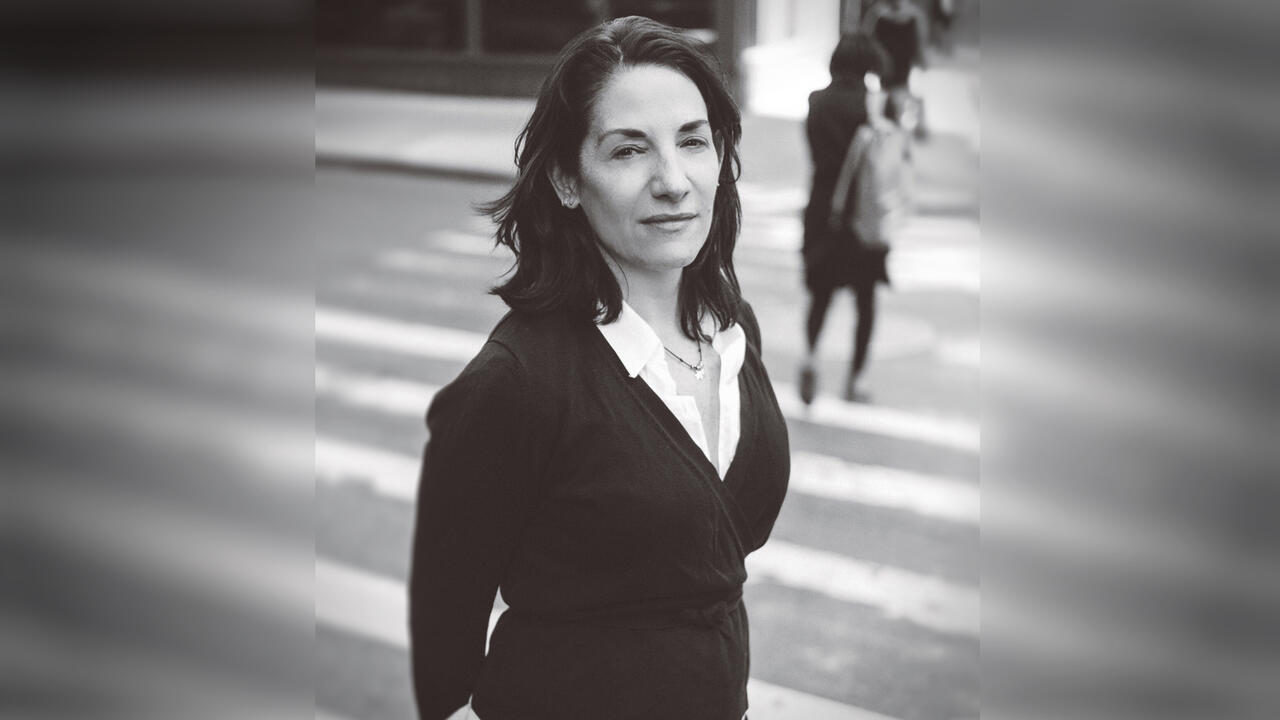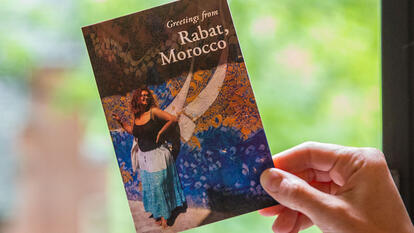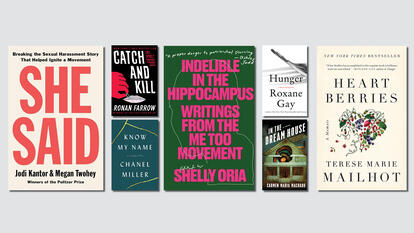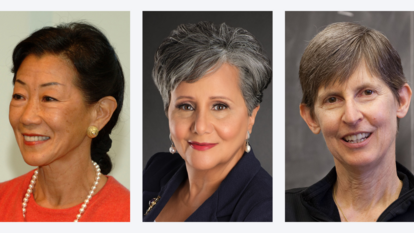
Listening to Herself: Elizabeth L. Reede ’84 Makes a Career in the Arts
When Elizabeth L. Reede graduated from Wellesley in 1984, the financial world was “having a moment,” as she puts it. Despite having majored in history and art history, she decided to try her hand at investment banking. Reede earned her MBA in finance and management policy from Northwestern’s Kellogg Graduate School of Management, then spent over a decade working in the industry. While she really enjoyed aspects of the job—building spreadsheets, working closely with companies and clients—something never felt quite right.
“I noticed that in my free time I gravitated toward the arts and humanities,” Reede said. “When you have free time in investment banking, you use it wisely, and when I did, I would always head right to the Met [Metropolitan Museum of Art] or the MoMA [Museum of Modern Art].” Reede found wandering around the galleries to be “regenerative,” and eventually she realized that she wanted to be in the museums every day, not just in her free time.
That realization eventually led her to found Boulevard Arts, a company that creates apps that use virtual, augmented, and mixed-reality technology to help museums and school districts expose more people to art, architecture, and cultural experiences. But it took many years, and a lot of listening to her gut, to get her to that point.
“I wanted to create something that offered authentic, democratized access to the public.”
Elizabeth L. Reede ’84
When Reede realized she wanted to leave banking, she wasn’t sure how best to pivot into a career in the arts. She had taken a memorable class on Egyptian art her senior spring at Wellesley with Professor Miranda Marvin, and though she worried the art history professor might not remember her, she figured it was worth reaching out to seek advice about switching careers. “Of course I remember you,” Marvin said when she heard from Reede. “I knew you’d come back from the dark side.”
Marvin encouraged Reede to pursue a graduate degree, which she did, earning her master’s in art history from Williams College. She was hired by MoMA while working on her Ph.D. at NYU’s Institute of Fine Arts, and decided to focus on her curatorial work there instead of completing her degree. At MoMA, Reede worked in the Department of Painting and Sculpture for over a decade, starting out as a curatorial assistant for Kirk Varnedoe, then chief curator, and continuing to work for other luminaries in the field, such as Robert Storr and John Elderfield.
MoMA had an unspoken policy that wall labels next to the pieces of art should be brief and to the point. In most cases, that made sense to Reede, but she also felt that the concept needed to be considered more broadly, with a more diverse population and demographic in mind. “What happens if there is someone there who doesn’t go to a lot of museums, who feels intimidated, who doesn’t understand what they are seeing, and is seeking a way to just start the looking or engagement process?” she wondered. “How do we help those visitors feel supported and invited to engage on their terms? Alternately, what about the more knowledgeable visitor, for example, a graduate student who may come to the museum for research and wants as much in-depth information as possible?”
Reede, who had become interested in technology in the finance world, had used the museum’s collection management system while working on several exhibitions, including Jackson Pollock, the reinstallation of the Painting and Sculpture collection in the then-new Taniguchi building, Martin Puryear, Rothko/Reinhardt, and Ellsworth Kelly. She wondered how to make this more comprehensive information accessible to the museum’s visitors, too, not just the curators. What if people could easily access more details about a work of art, or learn and think about what they’d seen after they left the museum? Could the art viewing experience be customized?
By this point it was the early 2000s, and PalmPilots were all the rage. Reede began to imagine a similar device that could be used to read additional content, either at the institution or at home. It would be a way to hold the entirety of a museum in one’s hand. At the time, she had two young children and she was busy with other work, but the idea continued to build in the back of her mind.
“I wanted to create something that offered authentic, democratized access to the public,” Reede explained, “that would give people the keys to see and experience artifacts that represent all of human civilization.” She thought about a place like the British Museum, which contains 2 million years’ worth of human history and culture, and how fantastic it would be if people didn’t have to travel to London to visit its collections. “Ethically, philosophically, and intellectually I believed deeply in this concept,” Reede said. Finally, in 2013, this vision became a reality, and Reede started Boulevard Arts with co-founder Rob Hamwee, CEO of New Mountain Finance and managing director of New Mountain Capital.
“Listen to what you are saying to yourself, and pay attention to what interests you."
Elizabeth L. Reede ’84
Boulevard Arts combines Reede’s love of art and technology with her passion for cultural accessibility and education. “We want you to feel like you are being teleported and transported, feeding you amazing access and information in a really delightful, really interactive way,” she said. Viewers can explore objects from London’s National Portrait Gallery, the British Museum, the Smithsonian’s National Museum of African American History and Culture, the U.S. Capitol, the National Gallery of Art, the Library of Congress, and the White House, for example, all without leaving their sofa.
At the beginning of spring 2020, when most museums had to close and the lack of visitors threatened their grants and funding, Reede and her team offered to continue their work for free. “Just give us access to your collections,” Reede told the institutions, “and let’s feed the beast.” During the pandemic, Boulevard Arts gave people stuck at home a lifeline, offering new ways to see and explore art and culture.
Exploring art is also a way for people to learn how to better understand each other. Recent and ongoing social justice movements are, in part, calls for greater empathy, and Reede feels that through contextualizing art, people can experience not only the formal object itself but the relevance of the object for that moment. Ultimately, she said, that opens up a greater understanding of our historical connections as humans. This global framework encourages people to talk with each other, and that is the crux of all of Boulevard Arts’ immersive offerings.
Most recently, the company has been developing an augmented reality app for the Museum of Fine Arts, Boston, exploring images created by Polish photojournalist Henryk Ross that he took between 1940 and 1944 inside the Lodz Ghetto, which comprised the second largest population of Eastern European Jews outside of Warsaw. The MFA app is being delivered in augmented reality and will be available for use on iOS smart devices. It will let viewers engage more intimately with Ross’s photos, offering them a unique opportunity to bear witness to the grim everyday realities of life in the ghetto. On June 24, from 6 to 7p.m., the MFA will host a virtual event, co-sponsored by Wellesley College Friends of Art and Wellesley Jewish Alumnae, about Ross’s photographs and the immersive app. Registration is free and open to the public.
Boulevard Arts came about, Reede said, because she took the time to listen to herself. She paid attention to what she was drawn to in her free time, sought advice from her former Wellesley professors, and let herself take a leap and change careers. When asked what advice she has for others who might want to switch directions, Reede said: “Listen to what you are saying to yourself, and pay attention to what interests you. Give it a moment. There is a reason for it … it’s called intuition.”



